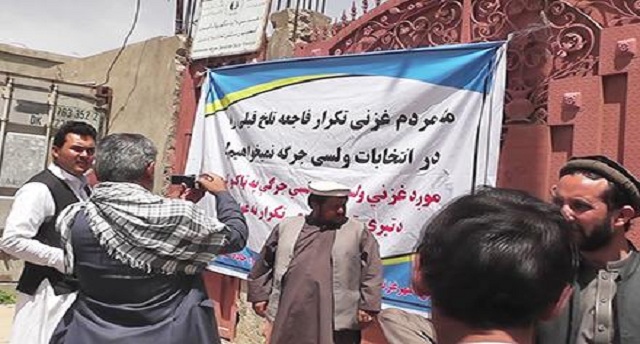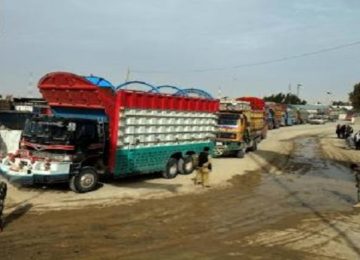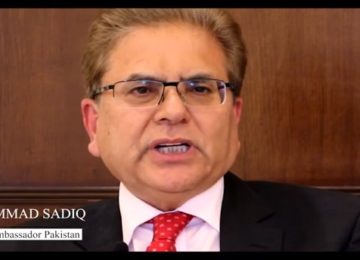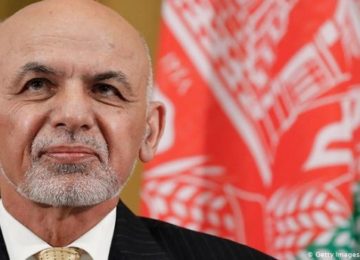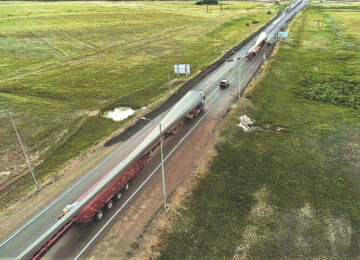Protests continue in front of the Independent Election Commission’s office in Ghazni, though it was able to reopen on 27 June following a 63-day sit-in protest at its gates that shut it down, stymying election preparations throughout the province. This comes despite the IEC’s legally problematic about-face to split Ghazni province’s electoral constituencies for the upcoming polls, according to the protestors’ wish. Protests are now taking place over the issue of which areas will be allocated to the new constituencies while others deem the split to be illegal. The original protest was motivated by the outcome of the 2010 parliamentary elections, when all seats in the province went to Hazaras following a low Pashtun turnout. AAN’s Ali Yawar Adili looks at Ghazni’s protestors’ demands as well as the IEC’s reactions to them, and concludes that both the government and the IEC face a dilemma about how to hold an inclusive election.
This is part nine of a series of dispatches looking at the preparations for the parliamentary elections. Part one dealt with political challenges; part two with an initial set of technical problems, including the date, budget and use of biometric technology; part three with electoral constituencies; part four with controversies surrounding the appointment of a new IEC member after its former chief was sacked by President Ghani; part five with a demand by political parties to change the electoral system; part six with the date of the polls and with voter registration; part seven with a deficient polling centre assessment, and; part eight with controversies over voter registration.
The IEC has decided to split Ghazni province into three separate electoral constituencies for the parliamentary elections scheduled for 20 October 2018. The IEC ‘s decision came on 25 June in which it said that “considering the recent problems in Ghazni province and given the protests and repeated demands of people of Ghazni province, the Independent Election Commission after sending an authorised delegation [referring to the 28 May delegation it had sent to Ghazni] and listening to comprehensive views of the people of the province on solving the existing problem and in consultation with relevant government agencies and civil [society] organisations, decided in accordance with paragraph two of article 35 of the electoral law that Ghazni be exceptionally divided into three constituencies and voter registration and candidate nomination be carried out in the province as soon as possible in order to ensure justice in representation.” (See here and here). With this, it revoked its 20 May decision (here and here) not to change the previous practice of using the country’s 34 provinces as unitary, multi-seat constituencies in the upcoming parliamentary polls.
The IEC’s decision is another U-turn. In late 2016, it was actually tasked by President Ashraf Ghani, through a presidential decree, to come up with a solution that would prevent the repetition of ethnically unbalanced elections outcomes such as the one in Ghazni in 2010, and suggested in February 2017 to split up a number of populous provinces into smaller constituencies. The proposal did not pass the cabinet, though. On 20 May, the IEC finally announced, based on a legal opinion from the Palace, that there would be no changes to the constituencies (see AAN’s previous report on the background discussion on the debate about electoral constituencies here).
The second U-turn – of only splitting the Ghazni constituency – only came after dozens of people, mainly Pashtuns but also some Tajiks and Sayyeds, had forced a shutdown of the IEC provincial offices in Ghazni city for more than two months, from 26 April to 27 June. They were protesting that insecurity in this multi-ethnic province in south-eastern Afghanistan might lead to lopsided participation in the districts – high in the Hazara areas, low in the Pashtun areas – if the IEC left electoral constituencies unchanged. This raises the chances that the divisive outcome of the 2010 parliamentary election in Ghazni could be repeated. That year, all 11 Wolesi Jirga seats in the province went to Hazaras, with no Pashtun representation. Then-President Hamed Karzai intervened and tried to broker a deal that would have partly revoked the results but failed (see AAN’s reporting here and here). Both groups make up almost half of the province’s population according to a UN provincial profile, with Pashtuns’ numbers slightly higher. (1)
The recent protest led to almost a complete halt of electoral operations in that province.The ‘how’ of the IEC decision, however, is still opposed by some of the original protestors but, more importantly, has also produced further backlash. This came from the Hazara residents of the province who started their own protest against the decision on 28 June and shut down the IEC office on 2 July once more. They argue that the IEC decision to split the province is illegal.
Who are the original protestors?
13 days into the first phase of voter registration in the provincial capitals (see AAN’s previous reports here and here), on 26 April protestors shut down the IEC provincial office in Ghazni city by pitching a tent at its gate and starting a sit-in. They called for dividing the province into smaller electoral constituencies in order to ensure balanced ethnic representation. (It has been difficult to verify the exact number of the protestors; an Afghan media report put their number at some “dozens.”).
The demand (and similar demands raised in other provinces such as Maidan Wardak) (2) had previously been dampened by the IEC 20 May decision (here and here) not to change the constituencies for the 2018 Wolesi Jirga election.
Mawlawi Muhammad Ismail Ruhani, a Pashtun protest leader, Islamic scholar and potential parliamentary candidate from Giro district of Ghazni, told AAN on 30 May that the reason for the sit-in was to “see ourselves [represented] in the framework of the system and parliament.” He added that over the last eight years, local Sunnis did not have any representatives in parliament, “because our areas and districts are under the Taleban’s influence [or] threat, and therefore our people could not participate in elections.” He referred to the fact that most of the Pashtun-dominated districts are either controlled or contested by the Taleban. (3) Ruhani insisted that the protest was not Pashtun-only. According to him there was a leadership council of 22 people – four Tajiks, one Sayyed and 17 Pashtuns – which led the sit-in tent and organised the protestors. (4)
Abdul Razeq, the second protest leader, a Tajikfrom Ghazni centre, also claimed that the protestors include ordinary Pashtuns, Tajiks and Sayyeds from various parts of the province. A source from the IEC Ghazni provincial office told AAN on 30 May that the demonstrators also include a number of potential Pashtun and Tajik candidates. Among them, according to the source, were two Tajiks from the provincial capital, Dr Ismail Khanjar and Mualem Razeq, and 12 Pashtun candidates from the rural districts. Ruhani admitted that some, including himself, would likely be candidates, too. Still, he estimated that more than 180 candidates would be nominated from the Pashtun, Tajik and Sadat communities and not all of them were part of the protests.
What are the protestors’ demands?
The protestors’ main demand was to divide Ghazni into 11 electoral constituencies, corresponding with the 11 seats the province has been allocated in parliament. This, in effect, would result in single-member constituencies and break with the multi-member constituencies under the prevalent SNTV electoral system.
The protestors’ reasoning is that if the whole province is used as a single, multi-member constituency, candidates in insecure districts will not get enough votes as had happened during the previous parliamentary elections in 2010. Then, Pashtun candidates were disadvantaged in relation to Hazara candidates who mainly live in secure districts. But if the province is divided into 11 constituencies, there will be a candidate elected from each of those constituencies, regardless of varying voter turnout in the districts.
The government, however, rejected this demand. On 13 June, the president’s deputy spokeswoman, Durani Waziri, told AAN that the law must apply to all provinces equally, that there would be no exception for Ghazni province and that it was legally impossible to divide the electoral constituencies at this late stage. She ruled out any separate Ghazni ‘solution’ “hundred per cent”, calling such a thing “irrational.” The government, she said, was instead “trying to ensure security.”
The protestors also have a number of other demands. Firstly, they are calling for an extension of voter registration and distribution of tazkeras. This emanates from the fact that the IEC office in Ghazni has been closed during almost the entire registration period affecting all electoral activity in the province. Secondly, they demand that the IEC bring ethnic balance to its provincial office. Ruhani claimed that among 15 key provincial IEC positions, only two are occupied by Pashtuns, one by a Tajik and another by a Sayyed. The remaining positions are occupied by Hazaras, whom he described as dominating the IEC office. Nazer Hussain Nabizada, the acting head of the IEC Ghazni office, rejected this claim. He said there was a mix of Hazara, Pashtun, Tajik, Sayyed and Bayat employees in the office, hired based on tests conducted under the supervision of an authorised delegation from the IEC headquarters in Kabul. (5)
Gender issues also appear to have played a role in the recruitment dispute. The local IEC official claimed that protestors refuse to allow women from their communities to work, and therefore wanted men recruited in place of women on the employee roster. The provincial IEC office said this was not possible.
Thirdly, the protestors want a rebalancing of polling centres and reopening of some polling centres that they claim have been closed by the IEC. Ruhani claimed in conversation with AAN that “14 districts plus the provincial centre had 85 polling centres while three Hazara districts alone – I mean the overall Shia population – had 174 polling centres.” The list of polling centres that AAN has received from the IEC Ghazni provincial official, however, contradicts this claim and shows 164 polling centres allocated to Pashtun dominated districts (see overview in footnote 6). Ruhani also questioned the location of some of the polling centres, saying that the IEC closed a polling centre in Khenyan village of Qarabagh district, which is the site of an Afghan Local Police headquarters but opened a polling centre in the remote village of Barla, which is a hotbed of the Taleban. Ruhani said that they wanted the polling centre in Khenyan to be re-opened. IEC member Hafizullah Hashemi told AAN that this was a legitimate complaint and the IEC was considering it. He added that the polling centres were assessed over a long period of time and “ghost polling centres were removed” but that security conditions could have changed in the meantime.
Nabizada said that the IEC allocated the polling centres fairly, but whether those centres were secured or not (and thus opened or not) was a different question. “Neither the IEC nor the Hazara residents could ensure their security,” he said. According to him, there are 406 polling centres in Ghazni in total, with 55 of them allocated to the provincial capital. Zaher Akbari, the head of IEC’s Paktia office who has been seconded to Ghazni as acting head to replace Nabizada following the protest, also said that the protestors had not been able to distinguish between the IEC’s polling centre assessment and the security review of the polling centres, but he admitted that there were some problems with the IEC assessment. (AAN previously reported that the assessment had been deficient.) Akbari also blamed the security forces for planning to secure only 260 out of the total 406 polling centres spread across the province. He claimed that this issue was soluble, but this does not seem to be a realistic promise given the very complicated security situation in the province. (7)
The problem of ethnic representation
The situation in Ghazni boils down to the issue of ethnic representation, which in turn stems from the persistent insecurity in most of the Pashtun-dominated districts. However, the protestors try not to frame the problem in ethnic terms. Ruhani told AAN, “We never say that our Shia brothers have taken our rights. We say that the president and the system [of government] have taken our rights.”
However, occasionally, the grievances are expressed in ethnic terms, including complaints that the current Ghazni MPs did not do anything for Pashtuns or Tajiks. These sentiments are occasionally expressed more directly, as on 5 May when protestor Mawlawi Rahmatullah Andar said that Ghazni MPs belonged to a single “tribe” and had been imposed on them. “They violate our rights instead of serving us,” he said. Even Ruhani, who claimed there was not an issue with the Hazaras, said that he argued with the IEC delegation that if the Pashtuns and Tajiks were not able to elect their representatives, then it would be a corrupt election and they would not participate in that as it would be assistance to the corruption, which, he said, “is not allowed by the holy Quran.”
The suspicion is mutual: Aref Rahmani, an MP from Ghazni, in a conversation with AAN, alleged that the government was plotting a conspiracy against Hazaras. He noted that when he was elected, the governor, provincial NDS director, and head of the IEC provincial office were all Pashtun. He further said that Ghazni MPs were shunned by the executive branch during the Karzai administration, meeting the Ghazni MPs only once and speaking to them dismissively.
It is difficult to judge these claims. However, they are used as a basis for arguments and as a departure point that now the Pashtuns want to get assurances ahead of the upcoming elections that not all the seats will go to the Hazaras, who, in turn, want to ensure that any political assurances do not tip the balance to their disadvantage.
The fallout of the protest
The sit-in and closure of the IEC office has stymied electoral operations in the province. The IEC launched the first phase of voter registration on 14 April, covering provincial capitals. It was supposed to end on 13 May but was extended until 12 June countrywide. The second phase started on 15 May and was supposed to end on 28 May in district centres, but was extended for ten days until 7 June (see the IEC’s decision here). A third phase was supposed to be carried out from 30 May to 12 June in rural areas, but was postponed until the end of the second phase. It started on 9 June and is supposed to end on 6 July. (See the IEC’s decisions here and here). The first phase was hampered by the protest in Ghazni, and the second and third phases have not started in the province at all.
Voter registration statistics released by the IEC on 14 June, covering the period between 14 April when the exercise was launched and 12 June when the first and second phases ended, show that only 57,951 people have registered to vote in Ghazni. The IEC Ghazni’s Nabizada told AAN that due to the closure of the Ghazni office, they were only conducting voter registration in the provincial capital. He said that most of the polling centres there were running out of registration materials and could not resupply because the additional material was stranded in the central provincial office. Nabizada further said that out of 55 polling centres in Ghazni centre, six were under high security threat and security agencies have declared in advance of voter registration that those centres would not open. According to him, as the voter registration started, IEC officials realised they could not open six more centres because of security problems.
Similar problems occurred during candidate nomination for both parliament and district councils, which started on 26 May and ended on 12 June (with nomination of district council candidates extended until 14 June). This activity has not yet been carried out in Ghazni at all. The candidate nomination statistics released by the IEC on 13 June show zero nominations in the province.
How the IEC tried to solve the problem
The IEC sent a two-member delegation to Ghazni on 28 May to talk to the protestors. (8) From the beginning, the IEC had emphasised that it wastrying to address the demands that fall under its authority but could not address two main demands: security and dividing the province into constituencies, which are the responsibility of the government. (As mentioned above, the government had already said there was no chance of dividing electoral constituencies but promised to provide additional security in the protestors’ areas.) Still, there are no indications that the government can actually secure those parts of Ghazni that are controlled by the Taleban. As a result, the IEC has addressed only one of the protestors’ demands, namely dividing the province into three constituencies.
When the IEC announced its decision to divide the province into three constituencies on 25 June, it emphasized, in order to prevent similar demands from other provinces, that this was “exceptional.” It further said that the Independent Directorate of Local Governance (IDLG) in cooperation with the Central Statistics Organisation (CSO) and other relevant agencies, in accordance with article 36 of the electoral law, and in understanding with the IEC, would be duty bound to draw the boundaries of the constituencies in the province in a balanced way, as stipulated by paragraphs four and six of article 83 of the constitution.
The IEC and IDLG have not explained publicly how exactly the three constituencies would be delineated and based on which considerations and criteria. Kabul daily Etilaat Roz, however, claimed it had obtained the documents. According to those, it reported, the province would not be divided fully along ethnic lines: one constituency with four parliamentary seats would consist of the two Pashtun-dominated districts of Ajrestan (majority Pashtun and some Hazaras) and Rashidan (Pashtun and Tajiks) as well as the three Hazara districts of Jaghori, Malestan and Nawur along with the mixed majority Hazara (along with Pashtuns, Bayat and Sayyeds, sometimes also called Sadat) district of Jaghatu. The second constituency, withfour seats, will bring together(a more diverse) Ghazni centre of Tajiks, Pashtuns, Hazaras, Bayats, Sayyeds, Sikhs and Hindus, the five Pashtun districts of Waghaz, Khugyani (both have Tajiks), Andar, Zana Khan and Deh Yak, along with the ethnically mixed district of Khwaja Omari (with a majority of Hazara along with Pashtuns, Bayats, Sayyeds and Tajiks). The third constituency, with three seats, will comprise the five Pashtun districts of Muqur, Gilan, Nawa, Ab Band and Giru along with the mixed Pashtun/Hazara district of Qarabagh. The three women seats of the province will also be divided among the three constituencies. (9)
A source from the IEC confirmed this proposed delimitation to AAN on 26 June.
Reactions to the decision
The decision has been criticised by some election observers as illegal (see Transparent Election Foundation of Afghanistan here). Yusuf Rashid, executive director of Free and Fair Election Forum of Afghanistan has also said that splitting the province into three constituencies is not “a simple question” and that it might not be implemented within one or two weeks.
In Ghazni itself, Mawlawi Rohani, the protest leader, told AAN on 26 June that they would continue their sit-in until there was a fair division of the Ghazni provincial constituency. He said that the province should be delimited differently. He argued that Ajrestan and Rashidan should not go with the secure districts of Jaghori, Malestan and Nawur as the two districts could not compete with them given their security situation. He also said that an earlier census undertaken in ‘Daud Khan’s time’ – the president between 1973 and 1978 – should be used for any redrafting of the constituencies (in fact no census ever took place in that time; he was very likely referring to the one started – and never completed – in 1979; see here). Rohani also worried about Pashtun women who, according to him, have mostly not obtained tazkeras,which would additionally negatively influence a possible turnout. However, a day later on 27 June, the protestors removed their sit-in tents and allowed the IEC office to reopen. Following this, Ismail told AAN that they would still continue to push for fair delimitation.
On the other hand, all 11 Ghazni MPs held a press conference on 26 June voicing their opposition to the IEC’s decision. (See the video here). Two days later, on 28 June, a number of Hazara residents in the province waged another protest and sit-in close to the IEC office, calling the IEC’s decision “totally illegal” and demanding that the commission revoke it. In a resolution (AAN has received a copy of it), they argued that given the social and ethnic fabric of the province, the decision to split the province was technically challenging and could cause social problems. Bashir Ali Shafaq, a protest organiser affiliated with Hezb-e Wahdat-e Mardom led by deputy chief executive Mohammad Mohaqeq, told AAN on 1 July that the protestors had moved their tent close to the IEC office gate the day before and that they would talk to the acting head of the office once he was back from Kabul. He said that if the IEC’s decision is not rescinded, the protestors would make their next move which could include shutting down the IEC office in Ghazni, which they did the following day.
These protestors are supported by Hazara political leaders. Karim Khalili, head of High Peace Council and head of another faction of Hezb-e Wahdat, on 28 June also called “the exceptional division of Ghazni into constituencies as illegal, unfair and not applied on all provinces (ghair-e sarasari).” A day later, Mohaqeq also criticised the decision as “against the electoral law” and “indicative of undue discrimination among brotherly ethnic groups of Afghanistan as well as an organised effort for countering the legal presence of some ethnic groups in the highest decision-making authority, the Wolesi Jirga.” The Hazara-dominated Enlightening Movement also joined in this opposition, saying the IEC’s decision could be accepted only if the province was divided into three or at least two provinces, not constituencies.A source from the office of Vice-President Sarwar Danesh – the highest-ranking Hazara politician in the government – had earlier told AAN that his position was that the entire Ghazni province, like all other provinces, should be used as one electoral constituency.
Conclusion: The problem of inclusive elections in war
If implemented the latest IEC decision will allow the Ghazni population to elect their representatives in a way that better reflects the province’s ethnic composition. But the devil is in the detail. Its concrete on proposal how to divide the province – which is not even officially public yet – has still to fully convince the original protestors. Furthermore, it has produced a new backlash from the Hazara residents of the province, backed by Hazara political leaders like Khalili and Mohaqeq at the national level.
On the other hand, the IEC’s bending to the protestors’ will – regardless of whether their demands are valid or not – has created a number of legal problems. First, the commission’s statement that this was “exceptional” for Ghazni is not very convincing, as it breaks with the general rule that could (if implemented – and the delineation of the new constituencies is still pending and fought over) open Pandora’s box, as people in other provinces have already made similar demands and might increase political pressure, too, if they see that the Ghaznawi people get their way. Secondly, the decision came more than two months after the legal deadline for any re-drawing of constituencies. If it is challenged in the courts, it might open up another legal battle that could drag on and impact the preparations for the elections.
If, on the contrary, the decision is not implemented, the original protestors might return to the scene. And this is possible: the country’s Independent Commission for the Oversight of the Implementation of the Constitution (ICOIC) has now called the IEC’s announcement about splitting the Ghazni constituency “outside the specified period [legal timeframe]” and “a violation of article 36 of the electoral law” in a statement issued on 1 July. In this light, it will be very difficult to find a way to fully please all parties involved.
Additionally, there is a larger practical double-bind. Without establishing security in the areas dominated by Pashtuns, any political solution for enfranchising them remains theoretical. The Taleban’s behaviour so far in 2018 suggests that the insurgents may be generally less willing to allow voter participation than in previous elections. (The Taleban have both threatened and called on the people to boycott the elections and backed up their threats with violence, see AAN’s previous report here. This might well play out in the Pashtun-dominated areas of Ghazni. Holding elections without securing these areas and without any division or any political solution prior to the elections, however, will most likely disenfranchise them. The issue has the potential to evolve into deeper conflict between the two ethnic groups in the province, and beyond, which may manifest itself in different forms.
Finally, the Ghazni elections tensions are just the tip of the iceberg, a result of the unfulfilled election reform promises of the National Unity Government. To hold elections that produce ethnically and otherwise inclusive representation in the provinces, while parts of them are controlled or contested by the Taleban (a problem aggravated by strong ethnic feelings), continues to be an almost insoluble dilemma for both the government and the IEC.
Edited by Graeme Smith and Thomas Ruttig
(1) As a result of the incomplete 1979 census (and none carried out later), no precise statistics exist about the country’s population in general and its ethnic breakdown in particular. The Central Statistics Office (CSO) does not provide any ethnic breakdown of the population in general and of the provinces in particular. According to a provincial profile updated by UNAMA in July 2017 (AAN has a copy of it), the province has, in total, a population of approximately 1.25 million: about 50 per cent Pashtun, 44 per cent Hazara, and six per cent Tajik. A source from the CSO who did not want to be named, told AAN on 12 June that the UNAMA statistics do not reflect reality as they fail to account for minority groups such as the Bayat, Qezelbash and Sadat. In the absence of reliable statistics, people from different groups in Ghazni tend to inflate the size of their own ethnic group.
(2) A day before the IEC announced its decision to declare each of the provinces as an electoral constituency, on 19 May 2018 residents of six districts in the neighbouring province of Maidan Wardak gathered in the provincial capital, calling for a division of the electoral constituencies. (See media report here). According to their resolution (AAN received a copy of it from IEC’s Maidan Wardak provincial electoral officer on 21 May 2018), they demanded that Maidan Wardak province be divided into “small constituencies.” Maidan Wardak has nine districts, including the provincial centre. They are: Maidan Shahr (provincial centre), Nerkh, Jalrez, Chak, Sayyed Abad, Daimerdad, Hessa-ye Awal-e Behsud, Jaghatu and Markaz-e Behsud. It has five seats in the Wolesi Jirga. In the 2010 parliamentary elections, three of them (two female and one male) were won by Hazara candidates and the remaining two by Pashtun candidates. The result of the 2005 parliamentary elections was even worse for the Pashtuns in the province as it “returned four Hazara and only one Pashtun to the house” (see this AAN’s previous report here). Election observer organizations had also highlighted similar problems “in Ghazni, Maidan-Wardak, Kapisa and Baghlan” (see media report here).
(3) According to the Central Statistics Organisation’s (CSO) latest population estimate of the year 1397 (2018-19) (see here), Ghazni has a population of 1,315,041. It has 19 districts, including the provincial centre. These districts can be divided into three categories: ten Pashtun-dominated districts (Andar, Waghaz, Khugyani, Zana Khan, Deh Yak, Muqur, Gilan, Nawah, Ab Band and Giro) with a population of 487,713; three Hazara districts (Jaghuri, Malestan and Nawur) with a population of 385,585 and ; ethnically mixed districts: two Pashtun majority districts (Ajrestan and Rashidan) with a population of 51,070; two Hazara majority districts (Jaghatu and Khawja Omari) with a population of 55,305; and Qarabagh and Ghazni centre where there is a lack of clarity about their ethnic balance and with a population of 335,361.Waghaz, Khugyani, Rashidan and Ghazni centre have varying numbers of Tajiks, while Jaghatu and Khawja Omari and Ghazni centre have a varying degree of Bayat and Sayyeds. A small number of Sikh and Hindu also live in the centre. This is a rough assessment of the spread of ethnic groups across the province and the AAN’s calculation of the district’s population above is based on the CSO’s population estimate.
According to the January 2018 quarterly report of the US Special Inspector General for Afghanistan Reconstruction (SIGAR), of these districts, six are contested: Ajrestan, Andar, Giro, Zanakhan, Waghaz, Qarabagh; 11 districts are under the government’s influence: Khugyani, Rashidan, Nawur, Muqur, Malestan, Khawja Omari, Jaghuri, Ab Band, Deh Yak, Gilan, and Jaghatu; one is under government control: Ghazni; and one is under insurgent control: Nawa. This assessment may not reflect the fluid security situation in the province. AAN research (forthcoming) shows that the government controls the three Hazara districts of Jaghori, Malestan and Nawur and central Ghazni city. The Taleban do not hold any part of Jaghatu or Khawja Omari but do threaten them. Nawa is fully controlled by the Taleban and the rest are largely controlled by the Taleban with only district centres under the government’s control.
(4) He provided the following list of leadership council members: 1) Mawlawi Muhammad Ismail Ruhani; 2) Zainuddin Bazaz; 3) Abdul Bari Khanikhel; 4) Muhebullah Khpelwak; 5) Ali Khan Andar; 6) Abdul Razeq; 7) Muhammad Ismail Khanjar; 8) Sayyed Obaidullah Sadat; 9) Khalilullah Hotak; 10) Muhammad Mirza Hemmat; 11) Mirza Andar; 12) Fariduddin Waezi; 13) Mawlawi Hakimullah Lailzai; 14) General Turan Tarakai; 15) Muhammad Sharif Amiri; 16) Naqibullah Tarakai; 17) Humayun Alikhel; 18) Muhammad Faruq Poya; 19) Ataullah Mujahed; 20) Naqibullah Khaksar; 21) Abdul Bari Shelgarai; 22) provincial council member Amanullah Kamrani (see AAN’s report here). At least two of them, Kamrani and Hotak have had connections with local anti-Taleban uprising forces (more on this in a forthcoming AAN dispatch about ALP).
(5) Earlier, on 24 May 2018, Aref Rahmani, one of the incumbent MPs from Ghazni, described the IEC recruitment as follows: the IEC recruited two Pashtuns but they turned out to be on the IEC blacklist for involvement in fraud during previous elections. Then the IEC recruited two people from the waiting list who happened to be Hazara. He claimed that the IEC provincial office did not have any role in their recruitment. He further claimed that the IEC members acknowledged this when the MPs from Ghazni met them on 20 May. IEC member Hafizullah Hashemi told AAN that he had also heard this, but added the IEC was reviewing it. On 13 June, IEC chairman Gula Jan Abdul Badi Sayyad said during a press conference that the protestors had complained about recruitment and the acting head of the IEC provincial office, adding that the IEC “sent a new acting head – who is competent and we are sure that he can solve the issue – a week ago. We fully authorised him to revise and correct the recruitments that were said to have taken place based on tastes.” (See the video here). The new acting head of the Ghazni office, Akbari, a Pashtun, told AAN that there had indeed been biased recruitment in favour of one ethnic group (Hazaras), adding that the recruitment had been carried out by the provincial office under the supervision of the delegation from the IEC’s headquarters. He said that the IEC was reviewing the recruitment and tashkil (staff quota) and would revise the staffing based on the IEC’s procedures and human resource procedure.
(6) In response to this, Nabizada said that polling centres had been determined based on population and geographical distance. He said it was unfair to compare, for example, Hazara-dominated Khwaja Omari district with Pashtun dominated Andar district, because, according to him, Andar was a first-grade district, which was both physically larger and had more people than Khwaja Omari. By the same token, comparing Pashtun-dominated Zana Khan district with Hazara dominated Jaghori was unfair. He provided the following breakdown of polling centres per district: seven for Ab Band; eight for Ajrestan; 40 for Andar; 16 for Deh Yak; eight for Rashidan; nine for Zana Khan; 19 for Giro; 17 for Muqur; 14 for Gilan; eight for Khugyani; eight for Waghaz; 10 for Nawa; 37 for Nawur; 46 for Qarabagh; 31 for Malestan; 22 for Jaghatu; 7 for Khwaja Omari; 46 for Jaghuri; and 55 for Ghazni centre.
(7) According to UN figures, Ghazni was among the five provinces with the most security incidents in 2016 and among the six most violent between 15 February and 15 May 2018 (no similar UN figures exist for 2017). In a map depicting ‘conflict severity’ in 2017 – a combination of three indicators: security incidents, civilian casualties and conflict-induced displacement – UNOCHA places Andar district in the highest category. Most of the districts along the Kabul-Kandahar highway, Deh Yak, Ghazni centre, Waghaz, Qarabagh, Giro, Muqur and Gelan, and the western district of Ajrestan were in the highest two categories of conflict severity. The western districts of Jaghori, Malestan and Nawur are in the lowest category. (p65- 66) According to a January 2018 BBC report based on research conducted between 23 August and 21 November 2017, the Taleban fully control 14 districts nationwide, including the district of Nawa in Ghazni. Further, they have a ‘high’ ‘active and physical presence’ (districts attacked at least twice a week) in Rashidan, Jaghatu, Khwaja Omari, Zanakhan, Ghazni, Dehyak, and Andar. The rest of the province saw ‘medium’ (districts attacked at least three times a month) or ‘low’ Taliban presence (district attacked at least once in three months) except for Malestan and Jaghori districts.
(8) On 28 April, two IEC members Sayyed Hafizullah Hashemi and Quraishi travelled to Ghazni. According to Hashemi, they talked to the protestors and collected their views. Mawlawi Ruhani told AAN that the delegation assured the protestors they would arrange a meeting with the president on the division of the provincial constituency as this fell within his remit. Ruhani added that the delegation said the IEC would meet other demands under the IEC’s remit. Ruhani said that the sit-in tent is at the IEC office gate and would remain there until they had received a response from the president.
(9) According to the Etilaat Roz report, the proposal was discussed in a meeting attended by six IEC members (the seventh member, Wasima Badghisi, was absent), and ECC members, presidential representative Fazl Fazli, the chief executive’s representative Ghulam Faruq Majruh, IDLG representative Timor Sharan, NDS representative Ajmal Abedi, MoI representative Salem Ehsas, as well as representatives of ACCRA, CSO and the Land Authority. Sharan and Maleha both opposed the division and Maleha did not sign the IEC’s decision. (See here).
By Special Arrangement with AAN. Original link.
Disclaimer: Views expressed on this blog are not necessarily endorsed or supported by the Center for Research and Security Studies, Islamabad.



